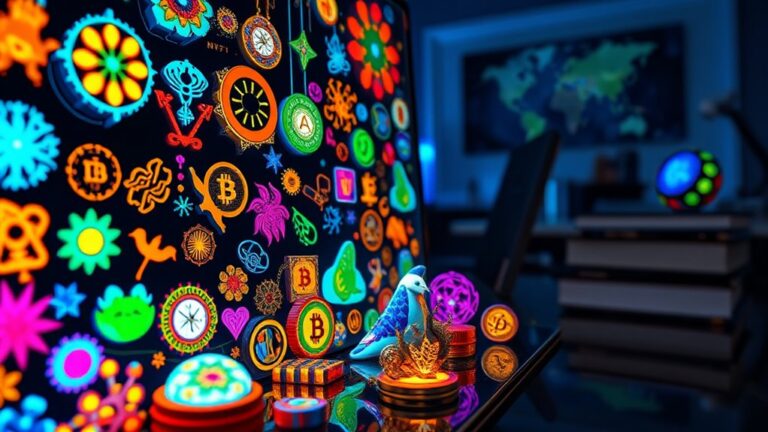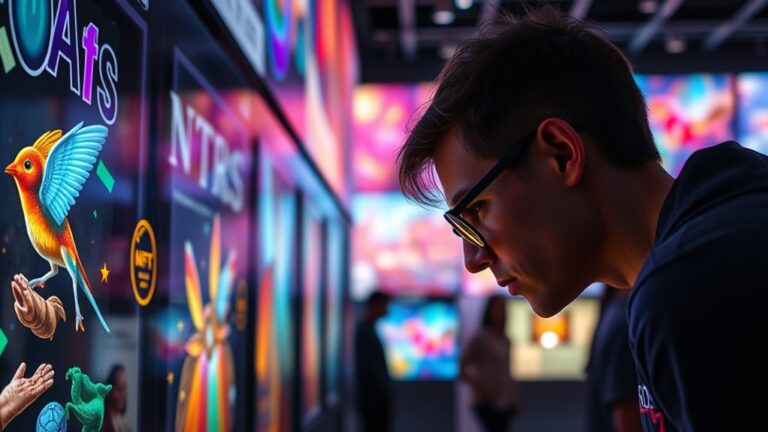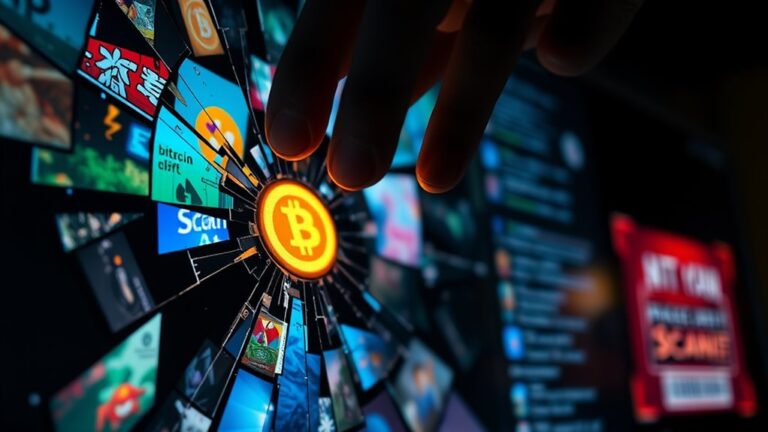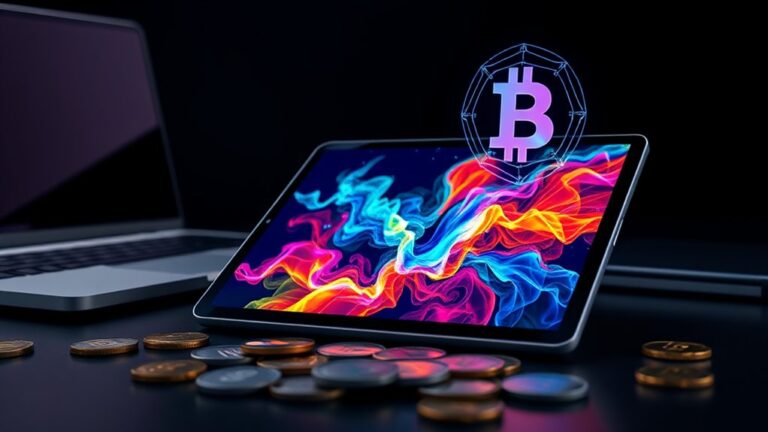
NFT Use Cases Beyond Art: Unlocking New Industries
NFTs are revolutionizing various industries beyond art by introducing innovative solutions. In gaming, they enable true player ownership, while real estate sees enhanced property transactions and fractional ownership through tokenization. In music, artists can directly monetize their work, increasing engagement. Charitable organizations benefit from transparent donations. Additionally, NFTs improve identity verification, manage supply chains, and create unique fan experiences in sports. These applications illustrate the breadth of NFTs’ impact across sectors, revealing further insights into their potential.
Key Takeaways
- NFTs facilitate fractional ownership in real estate, lowering investment barriers and increasing market liquidity through efficient and transparent transactions.
- In identity verification, NFTs enhance security and privacy, allowing users to control their identity information without intermediaries.
- NFTs boost charitable giving by creating direct connections between donors and charities, enabling ongoing royalties from resale for sustainable funding.
- In supply chain management, NFTs serve as digital twins to improve product tracking and prevent counterfeiting, enhancing transparency and regulatory compliance.
- Sports industries utilize NFTs for digital collectibles and tokenized tickets, enhancing fan engagement and creating new revenue streams through unique ownership experiences.
NFTs in Gaming: Revolutionizing Player Ownership
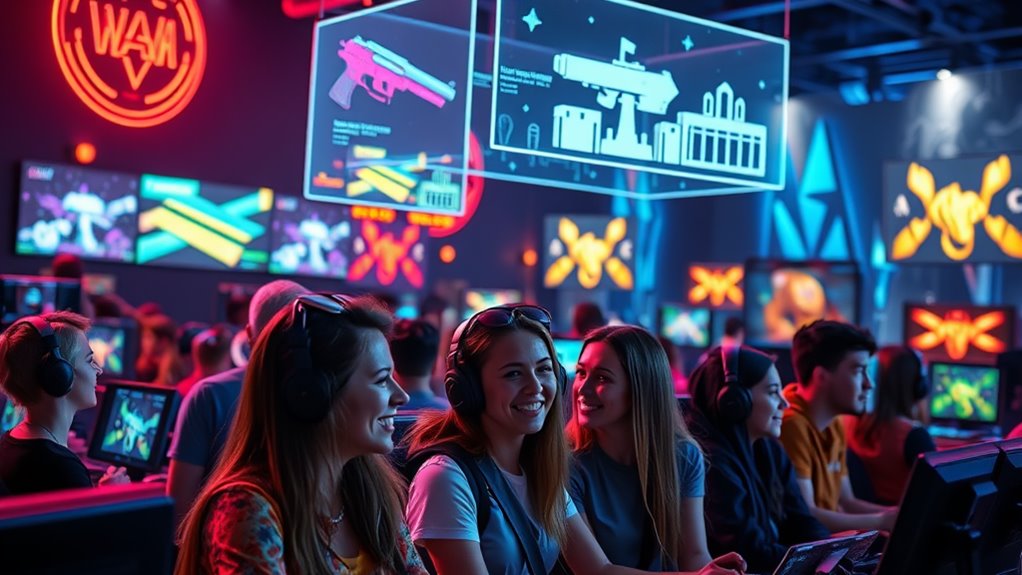
NFTs, or non-fungible tokens, are transforming the gaming landscape by providing players with true ownership of digital assets. This shift empowers gamers, allowing them to possess unique items that hold real value.
The NFT gaming market, valued at $4.9 billion in 2021, is expected to grow as players seek genuine ownership and engagement. Successful games like Axie Infinity highlight this potential, generating over $1 billion in revenue.
Players now have verifiable proof of ownership, enhancing their emotional investment in virtual worlds. Platforms such as Decentraland and The Sandbox further illustrate this trend, enabling users to buy and develop virtual properties as NFTs. Additionally, the rise of Play-to-Earn models in gaming is creating new avenues for financial incentives and player engagement.
This evolving dynamic markedly alters the player experience and increases the importance of digital assets in gaming.
NFTs in Real Estate: Transforming Property Transactions

As the real estate industry evolves, innovative technologies such as blockchain and non-fungible tokens (NFTs) are playing a significant role in transforming property transactions. NFTs facilitate tokenization, allowing for fractional ownership, which lowers investment barriers for small investors and first-time buyers. Blockchain reduces transaction times by up to 80%, streamlining processes and cutting costs through smart contracts. Additionally, the immutable nature of blockchain enhances transparency and security, fostering trust among participants. This trend aligns with the growing emphasis on real-world asset tokenization, which is becoming a key trend in the NFT landscape.
| Benefit | Description | Impact |
|---|---|---|
| Accessibility | Fractional ownership lowers barriers | Promotes inclusivity |
| Efficiency | Faster transactions with less paperwork | Increases market liquidity |
| Transparency | Immutable records reduce fraud risks | Builds trust in transactions |
This framework encourages a democratized investment approach.
NFTs in Music and Entertainment: Direct Monetization for Artists
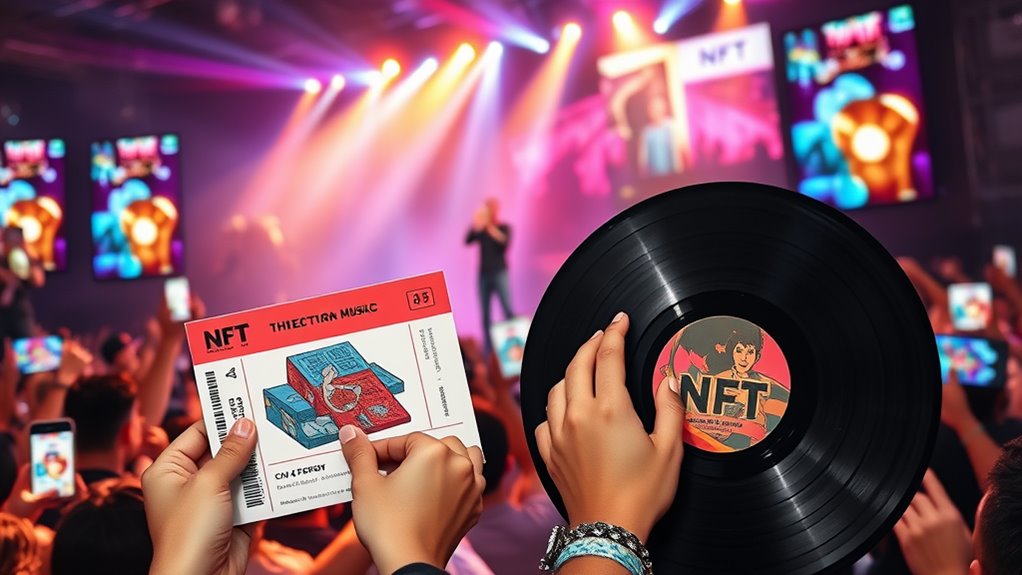
The emergence of non-fungible tokens (NFTs) is reshaping the landscape of music and entertainment by offering artists innovative ways to monetize their work.
By leveraging NFTs, artists can create new revenue streams and gain greater control over their creations.
Key benefits include:
- Direct Sales: Artists can sell exclusive content, such as unique tracks or digital artwork, directly to fans.
- Bypassing Intermediaries: Releasing music as NFTs allows artists to avoid traditional intermediaries, enabling them to keep a larger share of royalties.
- Enhanced Fan Engagement: NFTs facilitate direct connections between artists and fans, offering exclusive experiences and fostering loyalty.
As the market for music NFTs grows, these digital assets are transforming how artists approach monetization and engage with their audiences. Additionally, music NFTs provide transparent and verifiable ownership, ensuring authenticity and scarcity for both artists and fans.
NFTs in Charity and Fundraising: Innovating Philanthropy

NFTs are emerging as a transformative tool in the domains of charity and fundraising, providing new methods for digital asset donations and unique experiences.
By auctioning NFTs, organizations can engage donors while ensuring transparency in fund allocation through blockchain technology.
This innovative approach not only broadens the reach of charitable efforts but also strengthens the connection between donors and causes, fostering a community of support.
Digital Assets for Donations
In recent years, innovative approaches to philanthropy have emerged, particularly through the use of digital assets like non-fungible tokens (NFTs) for charitable purposes.
These NFTs serve as a novel form of donation, leveraging blockchain technology to enhance transparency and engagement.
Key aspects of this trend include:
- Direct Connections: NFTs facilitate direct interactions between creators, donors, and charities, eliminating intermediaries.
- Financial Contributions: Crypto donations, including NFTs, have noticeably boosted charitable giving, with major donations reaching millions.
- Ongoing Royalties: Nonprofits can earn continuous support through royalties from NFT resales, ensuring sustainable funding.
This approach not only modernizes philanthropy but also fosters community collaboration, creating a dynamic ecosystem for charitable initiatives. Additionally, like ICOs in crowdfunding, NFTs represent a new frontier in fundraising that allows for diverse revenue streams for charities.
Auctioning Unique Experiences
Unique experiences are increasingly being auctioned as NFTs, presenting a fresh avenue for charitable fundraising. For instance, notable events like Coachella offer lifetime festival passes as NFTs, merging digital collectibles with tangible benefits.
This innovative approach reduces logistical costs compared to traditional charity auctions, making fundraising more efficient. Collaborations with influencers or artists can enhance the visibility of these campaigns, broadening their reach.
Additionally, NFTs foster community engagement among supporters, creating a sense of belonging while allowing global participation in charity auctions. The integration of technologies like virtual reality can also provide immersive experiences for donors, further increasing the appeal of these unique offerings. Furthermore, the rise of utility NFTs is expected to enhance these fundraising efforts by providing even more value to donors through exclusive benefits.
This modern method of fundraising is reshaping philanthropic efforts across various sectors.
Transparency in Fund Allocation
While many traditional fundraising methods often lack transparency, the integration of blockchain technology in charitable initiatives offers a solution that enhances trust and accountability.
NFTs play a vital role in guaranteeing that donations are used effectively and transparently through various mechanisms:
- Transparent Transactions: Blockchain provides an audit trail, allowing donors to see how funds are allocated.
- Smart Contracts: Automated distribution through smart contracts guarantees that donations reach intended recipients without mismanagement.
- Identity Verification: Decentralized systems verify the identities of donors and recipients, increasing trust in the process.
Additionally, leveraging effective fundraising platforms can further streamline the process and enhance donor engagement.
NFTs in Identity Verification: Enhancing Security and Privacy
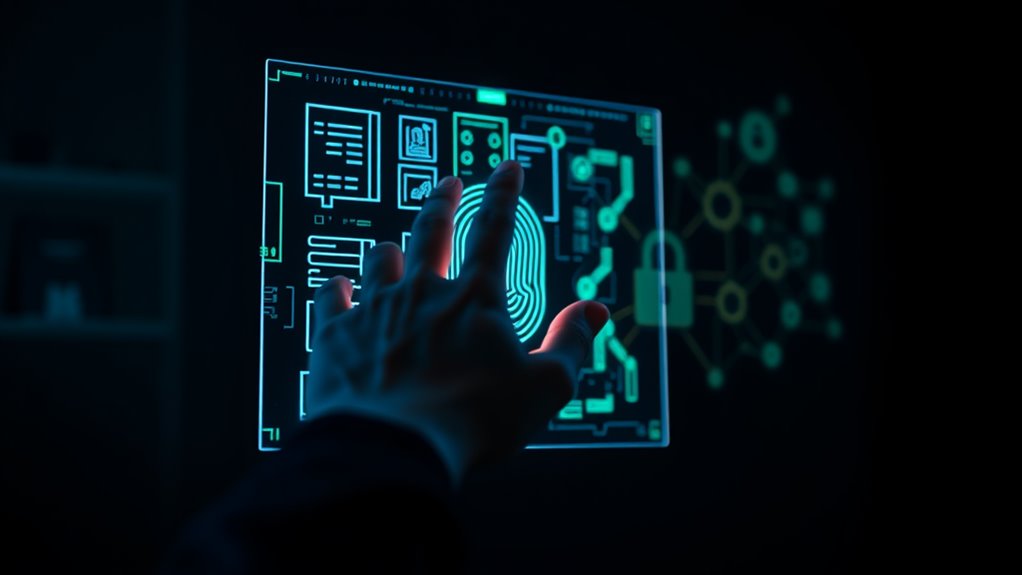
NFTs are revolutionizing the way identity verification is approached, offering enhanced security and privacy through blockchain technology. By utilizing decentralization, NFTs eliminate the need for intermediaries, resulting in tamper-proof records that individuals can control.
Users have full authority over their digital identities, determining who can access their information. This self-sovereign identity model not only enhances privacy but also reduces the risk of identity theft and data breaches. Each NFT contains a unique digital signature, enabling seamless verification without centralized authorities.
Additionally, sensitive data can be securely encrypted and stored, ensuring that only authorized parties can view it. As technological advancements continue, NFTs present innovative opportunities for secure identity management across various industries.
NFTs in Supply Chain Management: Ensuring Authenticity and Transparency

Supply chain management faces numerous challenges that can hinder efficiency and transparency. The integration of NFTs offers a potential solution to these issues.
- Enhanced Traceability: NFTs serve as digital twins for products, ensuring accurate tracking from origin to final destination.
- Counterfeiting Prevention: By providing tamper-proof records, NFTs make it nearly impossible to introduce counterfeit goods into the supply chain.
- Real-Time Monitoring: NFTs enable companies to monitor product status in real-time, improving decision-making and response times.
The use of NFTs not only increases transparency but also strengthens security, helping businesses maintain regulatory compliance and build trust with consumers.
As industries adopt this technology, they can expect significant improvements in efficiency and cost savings.
NFTs in Sports: Creating Unique Fan Experiences

As the landscape of sports continues to evolve, new technologies are reshaping the way fans engage with their favorite teams and athletes. NFTs are at the forefront of this transformation, offering unique digital experiences that enhance fan involvement.
| Feature | Description | Impact on Fans |
|---|---|---|
| Digital Collectibles | Unique digital versions of iconic sports moments | Ownership of memorable highlights |
| Supporter Tokens | Tokens for team decision participation | Increased engagement and influence |
| Virtual Reality Experiences | Immersive interactions with athletes and teams | Enhanced connection and experiences |
| Tokenized Tickets | Tradable digital tickets that become collectibles | Added value and flexibility |
Through these innovations, NFTs not only foster community but also create new revenue streams for sports organizations, allowing fans to participate in novel ways. As the metaverse expands, the integration of secure and decentralized transactions through cryptocurrencies will further enhance these fan experiences.
NFTs in Education: Credentialing and Verification of Achievements

The integration of blockchain technology in various sectors has opened new avenues for innovation, including education.
NFTs, or non-fungible tokens, serve as unique digital assets that securely represent educational achievements. Their implementation offers several key benefits:
- Streamlined Verification: Educational NFTs simplify and expedite the verification process for credentials, making them easily accessible in real-time.
- Fraud Reduction: The immutable nature of blockchain decreases the risk of fraudulent credentials, enhancing trust in educational achievements.
- Increased Control: Students gain more control over their credentials, allowing them to share information selectively with employers or institutions.
As educational institutions adopt NFTs, they can improve efficiency, reduce costs, and enhance their reputations, ultimately benefiting both students and the broader educational landscape.
NFTs in Fashion: Redefining Ownership and Exclusivity

NFTs are transforming the fashion industry by introducing digital fashion showcases and virtual wearable assets that allow brands to offer unique experiences.
These innovations not only enhance consumer engagement but also promote sustainable fashion solutions by reducing waste associated with physical production.
As the market evolves, the integration of NFTs may redefine concepts of ownership and exclusivity in the fashion world.
Digital Fashion Showcases
In recent years, digital fashion showcases have emerged as a transformative force in the fashion industry, redefining concepts of ownership and exclusivity.
These platforms, such as Decentraland’s Metaverse Fashion Week, allow luxury brands to engage consumers in new ways.
Key aspects of digital fashion showcases include:
- Enhanced Brand Visibility: Virtual stores in metaverse environments increase exposure for luxury brands.
- Authenticity and Ownership: NFTs linked to digital fashion items verify ownership and prevent counterfeiting.
- Community Engagement: Exclusive NFT drops and virtual events foster excitement and loyalty among consumers.
As brands leverage these showcases, they create innovative experiences that blend physical and digital domains, ultimately reshaping how consumers interact with and perceive fashion in the digital age. Moreover, the rise of Virtual Land NFTs enables brands to establish unique digital spaces for their fashion experiences, further enhancing their presence in the metaverse.
Virtual Wearable Assets
Virtual wearable assets represent a significant evolution in the fashion industry, fundamentally altering concepts of ownership and exclusivity.
These non-fungible tokens (NFTs) authenticate digital fashion items via blockchain technology, ensuring their authenticity and uniqueness. Consumers can own distinctive digital wearables, enhancing experiences in virtual environments such as metaverses and video games.
The value of these assets is influenced by their rarity and demand, driving interest in exclusive digital collections. Luxury brands leverage NFTs to offer limited edition items, which increases their desirability. Furthermore, platforms like OpenSea enable the buying and selling of these unique digital fashion assets, expanding their market reach.
Additionally, NFTs combat counterfeiting by providing transparent ownership records. Overall, virtual wearables foster innovative designs and promote a new culture around digital fashion, merging creativity with technology in unprecedented ways.
Sustainable Fashion Solutions
As the fashion industry faces increasing scrutiny regarding its environmental impact, innovative solutions are emerging to promote sustainability.
One such solution involves the use of NFTs, which enhance transparency and accountability in supply chains.
Key benefits include:
- Transparency: NFTs provide a public ledger that tracks the history of products, verifying eco-friendly claims.
- Incentives: They encourage suppliers to adopt sustainable practices through digital badges for eco-friendly actions.
- Circular Economy: NFTs facilitate the resale and recycling of garments, promoting longer product lifecycles.
Moreover, the fashion industry must consider the environmental impact of NFTs as they adopt these technologies to ensure that sustainability efforts do not inadvertently contribute to carbon emissions.
Frequently Asked Questions
How Do NFTS Impact Environmental Sustainability in Various Industries?
NFTs greatly impact environmental sustainability through high energy consumption, carbon emissions, and e-waste generation. However, solutions like Proof-of-Stake, transaction batching, and eco-friendly networks are emerging to mitigate these environmental challenges across various industries.
What Are the Legal Implications of Using NFTS in Different Sectors?
The legal implications of using NFTs across various sectors include intellectual property rights, regulatory uncertainty, compliance with anti-money laundering laws, securities classification, and jurisdictional challenges, necessitating thorough understanding and navigation of complex legal landscapes.
Can NFTS Help in Combating Counterfeit Products Effectively?
NFTs present a dual landscape: digital authenticity against physical vulnerabilities. While their immutable records enhance consumer trust and transparency, challenges such as technology limitations and lack of standards hinder their effectiveness in universally combating counterfeit products.
How Are NFTS Regulated Across Different Countries and Jurisdictions?
NFT regulations vary considerably across countries, often lacking specific laws. Many jurisdictions classify them as digital assets or investments, creating regulatory challenges and uncertainties, particularly regarding ownership rights and compliance with existing financial regulations.
What Technical Challenges Exist in Implementing NFTS on a Large Scale?
Only 15-30 transactions per second are processed by Ethereum, highlighting significant scalability challenges. Coupled with complexity, security risks, and interoperability concerns, these technical hurdles complicate large-scale NFT implementation and hinder widespread adoption.
Conclusion
The potential of NFTs extends far beyond the art world, influencing various industries considerably. For instance, a report indicates that the NFT market could reach $231 billion by 2030, highlighting its growing relevance. As sectors like gaming, real estate, and education begin to adopt this technology, the implications for ownership, verification, and monetization become increasingly profound. Understanding these applications can provide valuable insights into the future of digital assets and their role in transforming traditional practices.

